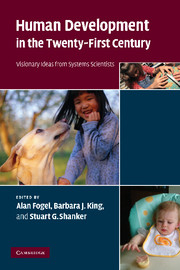Book contents
- Frontmatter
- Contents
- List of contributors
- Introduction: Why a dynamic systems approach to fostering human development?
- Part I Dynamic relationships between genetics and environments
- Part II The dynamic system of the child in the family
- Part III The dynamic system of the child in social and physical environment
- Part IV Dynamic systems approaches to mental health
- Part V Conclusions and outlook
- 24 A dynamic systems approach to the life sciences
- Index
- References
24 - A dynamic systems approach to the life sciences
Published online by Cambridge University Press: 22 September 2009
- Frontmatter
- Contents
- List of contributors
- Introduction: Why a dynamic systems approach to fostering human development?
- Part I Dynamic relationships between genetics and environments
- Part II The dynamic system of the child in the family
- Part III The dynamic system of the child in social and physical environment
- Part IV Dynamic systems approaches to mental health
- Part V Conclusions and outlook
- 24 A dynamic systems approach to the life sciences
- Index
- References
Summary
Each of the chapters in this book points to expanding our understanding of the multiple and complex relationships that surround development through the lifespan. In this chapter, we as the organizing committee of the Council for Human Development give a brief description and overview of the science of dynamic systems that is exemplified in the other chapters in this book. The goal of this chapter is to help people see how dynamic systems research helps us to understand human development and how it can assist in creating relevant policies and funding priorities.
The dynamic systems approach is fundamentally different from existing ideas about simple cause and effect. It begins with the realization that the living world is too complex for any one factor to have a significant effect on an outcome in the absence of many other competing and cooperating factors, all of which change over time. Dynamic systems scientists, such as the authors of the chapters in this book, seek to understand certain aspects of this constantly changing network of mutual influences according to their focus of study. The core of the notion of “system” is that it shows the relation of the “whole” and its “parts.” To think about dynamic systems means that we have always to consider the history of how the system under study – be this a single child with autism or an inner-city neighborhood – changes over time.
- Type
- Chapter
- Information
- Human Development in the Twenty-First CenturyVisionary Ideas from Systems Scientists, pp. 235 - 253Publisher: Cambridge University PressPrint publication year: 2007
References
- 1
- Cited by



